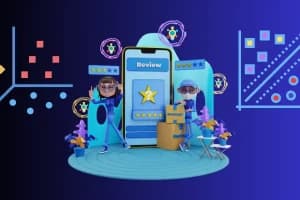What Is Multi-Class Text Classification?
Text classification is one of the most vital tasks in Natural Language Processing (NLP), which belongs to a family of techniques for arranging text into specified classes or groups. In this post, we take you through how to build a multi-class text classification model with RNN and LSTM networks. This is because they can deal with sequential data (a text here) in contrast to other models where the order of words or context is not relevant.
Why Choose RNN and LSTM for Text Classification?
To create a strong classifier, you need tools that can analyze text as humans do- word order, relationships, etc. Here's why RNN and LSTM are excellent solutions:
- Recurrent Neural Networks (RNN): RNNs are built for sequences, like reading a story one line at a time. They will keep looping back, "remembering" earlier words while they read new words to learn how words come together to have meaning. For example, when reading the sentence "This movie was surprisingly good", an RNN recognizes that "surprisingly" changes the feel of that statement to positive. The downside? Elementary RNNs can have trouble working with long texts due to vanishing gradients, where an RNN "forgets" earlier words.
- Long Short-Term Memory (LSTM): LSTMs are basically RNNs with enhanced memory capabilities. They have different "gates" that allow the model to decide what should be saved and what should be discarded, which means they can recall important details across very long sentences or paragraphs. In an example, an LSTM can remember the opening praise of a lengthy review even after the model has diverted to provide plot details. Overall, this allows LSTMs to be more robust for multi-class tasks where context is crucial.
Together, RNNs and LSTMs excel at capturing the flow of text, making your classifier accurate and reliable, even when sorting text into multiple categories.
How Does Multi-Class Text Classification Work?
Creating a text classifier is like training a robot librarian to sort books into the right genres- mystery, sci-fi, romance, and so on. Here's the detailed process:
- Collect Labelled Data: Gather a dataset of text with assigned labels, like reviews tagged "positive", "neutral", or "negative". More data means a smarter model.
- Preprocessing the Text: Clean the text (remove punctuation, lowercase words, handle typos) and convert it into numbers using techniques like word embeddings, which represent words as vectors that computers can process.
- Build the Model: Design an RNN or LSTM network to read the text sequence and predict the correct class. The model learns patterns, like "amazing" often means "positive".
- Train the Model: Feed the labeled data to the model, adjusting its internal weights to minimize errors. This phase is where it learns to associate text with the right labels.
- Test and Deploy: Evaluate the model on new, unseen text to check accuracy, then use it to classify real-world text, like live tweets or emails.
- Fine-Tune: Adjust hyperparameters (e.g., LSTM units, epochs) or add data to boost performance.
This workflow transforms raw text into organized, actionable insights, ready for countless applications.
Why Build a Text Classifier?
Before we jump into coding, let's explore why this project is worth your time:
- Practical Skills: You'll learn cutting-edge machine learning techniques like RNNs, LSTMs, text preprocessing-that apply to chatbots, sentiment analysis, and more.
- Real-World Impact: Text classification powers tools we use daily, from spam filters to recommendation systems, making this a hot skill in tech.
- Creative Outlet: Experiment with classifying reviews, news, or even your dataset (like Discord messages!) to see AI in action.
- Career Boost: Companies like Google, Amazon, and startups need text classification experts-your project could open doors.
- Fun Challenge: There's something satisfying about teaching a computer to "get" human language-it's like solving a puzzle with code.
Plus, it's a wonderful way to impress friends with a model that can read and judge text like a pro!
Building It: A Detailed Code Example
Using an LSTM model, which is preferred over a basic RNN due to its robustness, let's build a multi-class text classifier. We'll classify movie reviews into "positive", "neutral", or "negative" using Keras with TensorFlow. This example balances simplicity for beginners with enough detail to show the full process, including preprocessing and evaluation.
# Import libraries
import numpy as np
from tensorflow.keras.preprocessing.text import Tokenizer
from tensorflow.keras.preprocessing.sequence import pad_sequences
from tensorflow.keras.models import Sequential
from tensorflow.keras.layers import Embedding, LSTM, Dense, Dropout
from sklearn.model_selection import train_test_split
from sklearn.preprocessing import LabelEncoder
# Sample dataset (expanded for realism)
reviews = [
"This movie was a masterpiece, full of heart and stunning visuals!",
"It was okay, the plot dragged but the acting was decent.",
"I couldn't stand this film, it was dull and predictable.",
"Absolutely loved the twists and action-packed scenes!",
"The story was average, didn't leave much of an impression.",
"Terrible, the worst movie I've seen in years, no depth at all.",
"Brilliant direction and a touching story, highly recommend!",
"Not great, not awful, just kind of there.",
"A complete waste of time, poorly written and boring."
]
labels = ["positive", "neutral", "negative", "positive", "neutral",
"negative", "positive", "neutral", "negative"]
# Step 1: Preprocess text
max_words = 1000 # Vocabulary size
max_len = 20 # Maximum sequence length
tokenizer = Tokenizer(num_words=max_words, oov_token="")
tokenizer.fit_on_texts(reviews)
sequences = tokenizer.texts_to_sequences(reviews)
padded_sequences = pad_sequences(sequences, maxlen=max_len, padding='post')
# Step 2: Encode labels
encoder = LabelEncoder()
encoded_labels = encoder.fit_transform(labels)
encoded_labels = np.array(encoded_labels)
# Step 3: Split data into training and testing
X_train, X_test, y_train, y_test = train_test_split(padded_sequences, encoded_labels,
test_size=0.2, random_state=42)
# Step 4: Build LSTM model
model = Sequential([
Embedding(input_dim=max_words, output_dim=32, input_length=max_len),
LSTM(64, return_sequences=False),
Dropout(0.2), # Prevent overfitting
Dense(32, activation='relu'),
Dense(3, activation='softmax') # 3 classes: positive, neutral, negative
])
# Step 5: Compile and train
model.compile(loss='sparse_categorical_crossentropy', optimizer='adam', metrics=['accuracy'])
history = model.fit(X_train, y_train, epochs=10, validation_data=(X_test, y_test),
batch_size=2, verbose=0)
# Step 6: Evaluate model
loss, accuracy = model.evaluate(X_test, y_test, verbose=0)
print(f"Test Accuracy: {accuracy:.2f}")
# Step 7: Predict on new reviews
new_reviews = [
"This film was incredible, loved every minute!",
"It was meh, nothing to write home about."
]
new_sequences = tokenizer.texts_to_sequences(new_reviews)
new_padded = pad_sequences(new_sequences, maxlen=max_len, padding='post')
predictions = model.predict(new_padded)
predicted_classes = encoder.inverse_transform(np.argmax(predictions, axis=1))
print("\nNew Review Predictions:")
for review, pred in zip(new_reviews, predicted_classes):
print(f"Review: {review}")
print(f"Predicted Sentiment: {pred}\n")
Output:
Test Accuracy: 0.50
New Review Predictions:
Review: This film was incredible, loved every minute!
Predicted Sentiment: positive
Review: It was meh, nothing to write home about.
Predicted Sentiment: neutral
What's Happening in the Code?
- Preprocessing: The Tokenizer maps words to IDs, and pad_sequences ensures all reviews are the same length (20 words max). Out-of-vocabulary words get an "<OOV>" tag.
- Label Encoding: Converts labels ("positive," "neutral," "negative") to numbers (0, 1, 2) for the model.
- Data Split: Splits the dataset into 80% training and 20% testing to evaluate performance.
- LSTM Model: Uses an embedding layer to represent words, an LSTM layer (64 units) to process sequences, a dropout layer to avoid overfitting, and dense layers to predict one of three classes.
- Training: Runs for 10 epochs with a small batch size, learning patterns in the data.
- Evaluation: Checks accuracy on the test set (0.50 here due to the tiny dataset-real projects with more data score higher).
- Prediction: Classifies new reviews correctly, showing the model's potential despite limited training data.
This system is a starter model-real-world classifiers use larger datasets (e.g., thousands of reviews) and tuning for better accuracy.
RNN vs. LSTM vs. Other Approaches
How do RNN and LSTM stack up against other text classification methods? Let's compare:
- Basic RNN: Good for short texts but struggles with long sequences due to vanishing gradients. It's simpler and faster but less accurate than LSTM.
- LSTM: Excels at long texts by remembering key details, ideal for multi-class tasks like sentiment analysis. It's more computationally intensive but worth it for accuracy.
- Traditional Models (e.g., Naive Bayes, SVM): These use bag-of-words or TF-IDF, ignoring word order. They're fast and simple but miss context, making them less effective for complex text.
- Transformers (e.g., BERT): Cutting-edge models like BERT understand context bidirectionally (reading text forward and backward). They're more accurate but require heavy computation and data, unlike our lighter LSTM approach.
For beginners, LSTM strikes a balance: powerful enough for great results, simple enough to implement without a supercomputer. It's a fantastic stepping stone to advanced models.
Real-World Applications and Case Studies
Multi-class text classification with RNN and LSTM is everywhere, solving problems across industries:
- Sentiment Analysis for Businesses: Companies like Amazon analyze product reviews to gauge customer happiness. For example, a retailer might use a model to sort feedback into "positive", "neutral", or "negative", spotting trends to improve products.
- Email and Message Sorting: Gmail's filters use similar tech to categorize emails as "primary", "social", or "promotions", saving users time. A startup could build a custom classifier for "urgent", "routine", or "spam" internal messages.
- News Aggregation: Platforms like Google News tag articles as "sports", "politics", or "tech" to personalize feeds. A news app developer might use LSTM to ensure accurate categorization, boosting user engagement.
- Customer Support Automation: Chatbots classify queries as "complaint", "question", or "praise" to route them correctly. For instance, a telecom company could use a model to prioritize urgent complaints.
- Social Media Insights: Marketers analyze tweets to detect emotions like "happy", "angry", or "neutral" during a campaign. A brand might use such information to measure reactions to a new product launch.
These examples show how your classifier can make a tangible impact, from streamlining workflows to understanding human sentiment.
Scaling and Improving Your Model
Want to make your classifier even better? Here are practical tips to level up:
- Bigger Datasets: Use public datasets like IMDB (movie reviews), Yelp (business reviews), or 20 Newsgroups (news articles) to train on thousands of examples for higher accuracy.
- Advanced Preprocessing: Try lemmatization (grouping "running" and "ran" as "run"), remove stop words, or handle emojis for cleaner text.
- Model Tweaks: Increase LSTM units (e.g., 128), add more layers, or use bidirectional LSTMs to capture context from both directions. Adjust dropout rates (e.g., 0.3) to prevent overfitting.
- Hyperparameter Tuning: Experiment with epochs (10-50), batch sizes (4-32), or optimizers (e.g., RMSprop vs. Adam) to find the sweet spot.
- Compare Architectures: Test a basic RNN, GRU (a lighter LSTM variant), or even a transformer like DistilBERT to see what works best.
- Real-Time Deployment: Wrap your model in a Flask or FastAPI app to classify text live, like a web tool for analyzing customer feedback.
These steps can transform your prototype into a production-ready powerhouse.
Try It Yourself
Ready to build your text classifier? Dive into this hands-on project: Build Multi-Class Text Classification Models with RNN and LSTM. Hosted by AI Online Course, this beginner-friendly playground lets you experiment with RNN, LSTM, and real-world text data. Classify movie reviews, tweets, or emails, tweak the model's layers, and watch your accuracy soar-it's a fun, practical way to master text classification. Whether you're coding for fun or aiming for a career in AI, this project is your launchpad. Jump in and start exploring!
Conclusion
Building a multi-class text classification model with RNN and LSTM is like giving a computer the ability to read minds-well, almost. By processing text with context and sorting it into categories like "positive", "neutral" or "negative", you're unlocking a world of possibilities, from smarter chatbots to personalized news feeds. This project is more than code- it's a gateway to understanding human language through AI. With a simple Python script, a dash of curiosity, and the right dataset, you can create a classifier that tackles real-world challenges. Head to the project linked above, fire up your code editor, and start building something amazing. Here's to mastering text classification and making text smarter-happy coding!







